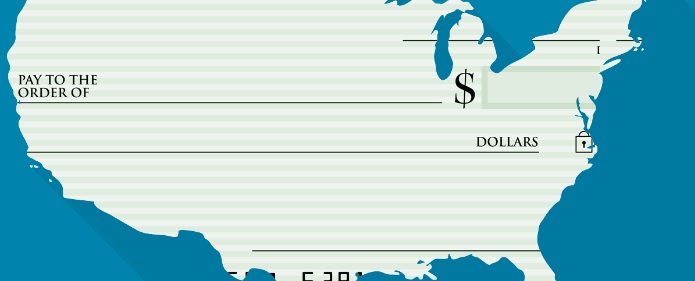Articles
Real-Time Payments: Would a Giro System Work in the U.S.?
- By Magnus Carlsson
- Published: 9/14/2016

This article originally appeared on LinkedIn.
Even with all the technological advancements in payments, about 50 percent of B2B transactions in the United States are still done by paper check. But the U.S. is fairly alone when it comes to check use. In other parts of the world, checks have almost disappeared in favor of electronic payments. This is partly due to the different setup of payments infrastructures in the industrialized world.
When comparing the U.S. with many European countries, there seems to be a major difference that plays an important part. The U.S. uses a “check model”, where checks are written by the payer and sent to the payee. To get the funds, the payee has to visit a bank, or mail the check to the bank (or lockbox) after which the process of clearing must take place before the funds can be made available.
In contrast is the “giro model”, which many European countries have used for a long time. This model is based on the concept of a direct transfer between accounts rather having a check intermediary. As an example of the giro model, the payer can send a request to pay the payee to the centralized postgiro center, which verifies available funds in the payer’s account, debits the account and then credits the payee’s account.
The Bankgirot system
How can payments be actual real-time, meaning clearing and settling, and made available within seconds? Well, I’m coming back to the giro model here and in particular I find Bankgirot’s solution in Sweden extremely interesting. Bankgirot is owned by the Swedish banks and is what can best be called a giro clearing system, as it operates both clearing and payments systems.
One of the features in the traditional Bankgirot payment system is the Bankgirot numbers. Once a client acquires a Bankgirot number they can connect it to their regular bank account. If a client changes banks, they can just connect their new bank account to the Bankgirot number. The Bankgirot number stays the same and does not change. Traditional payments are accepted, aggregated and cleared by Bankgirot, then settled at the RIX system (settlement system at the Swedish Central Bank).
Bankgirot’s Payments in Real Time system, which was launched in 2012, clears and settles payments in one to two seconds, 24/7! The key to achieving this can best be described as pre-funding. Each participating bank is required to, through their settlement account with the RIX System, pre-fund a separate fiduciary account in the RIX system held by Bankgirot. The bank is required to fund the fiduciary account with an amount estimated to be sufficient enough for the anticipated client payments. The necessary steps for these real-time payments are as follows:
- In the Payments in Real Time system, participating banks have settlement accounts for day and night transactions, respectively.
- Participating banks make estimates of the amount needed to cover the following day, night or weekend client payments. This because it’s a 24/7 system.
- The participating bank then transfers the estimated amount from its own RIX account with the settlement institute to Bankgirot’s Payments in Real-Time system’s RIX account. This is then booked against the bank participant’s special ledger account at Bankgirot’s Payments in Real Time system.
- Since all participating banks have these special, pre-funded, settlement accounts in the Bankgirot Payments in Real Time system, payments debited to a payer’s account can at the same time be credited to the payee’s account.
The pre-funding is essential for this system to work. Additionally, having pre-funded accounts removes any credit risk from the beneficiary bank. As the participating banks’ clients make payments, the balance on the bank’s settlement accounts with the Payments in Real Time system increases and decreases continuously. Payments can only be made as long as there is a positive balance on the bank’s settlement accounts within the system.
Since it really is the same liquidity moving back and forth between the settlement accounts, the actual amount necessary for pre-funding is in reality relatively low. Should the balance on the settlement account be at risk of going negative because of a payment, the payment will not go through and will be rejected. The basic reason for such a situation would relate to incorrect estimates of pre-funding levels. This is, however extremely rare and has only happened three times since the start in 2012.
Why business benefits
According to Johan Weijne, product manager, clearing and settlement at Bankgirot, the system has key benefits for corporate clients. “The most interesting feature of real-time payments is that it actually can affect the way we do business,” he said. “Much of our business processes are being automated, thanks to increasingly efficient ERP systems. Until now, however, the transfer of value through traditional payment systems is very slow. With real-time payments, the transfer of value can be integrated in the business processes in a completely new way.” Looking at it from this perspective, I think it is fair to say that real-time payments could certainly benefit corporates by making the entire business process more time- and cost-efficient.
Of course I understand the conditions are very different when comparing this situation with that of the United States. With thousands of banks, it would be very difficult to get them all to join one specific system. At the same time, if there was a system like this available, I’m sure there would be a strong appetite for banks to sign up, and be able to provide this service to their clients. What if they didn’t?
Yes, I’m being fairly simplistic but the bottom line is that it is important to realize that the technology for real-time payments is already being used. It is not a mystery anymore.
Magnus Carlsson is manager of treasury and payments for AFP.
Copyright © 2024 Association for Financial Professionals, Inc.
All rights reserved.

